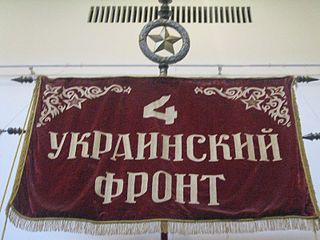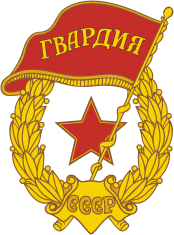The Southern Front was a front, a formation about the size of an army group of the Soviet Army during the Second World War. The Southern Front directed military operations during the Soviet occupation of Bessarabia and Northern Bukovina in 1940 and then was formed twice after the June 1941 invasion by Germany, codenamed Operation Barbarossa.
The Southwestern Front was a front of the Red Army during the Second World War, formed thrice.

The 4th Ukrainian Front was the name of two distinct Red Army strategic army groups that fought on the Eastern Front in World War II.

The 2nd Guards Tatsinskaya Tank Corps was a tank corps of the Soviet Union's Red Army that saw service during World War II on the Eastern Front of Europe. The unit's most notable moment was in the raid on Tatsinskaya during Operation Little Saturn in World War II. After the war, it continued to serve with the Soviet occupation forces in Central Europe. It was originally the 24th Tank Corps. The formation had approximately the same size and combat power as a Wehrmacht Panzer Division, and less than a British Armoured Division had during World War II.
The 63rd Army was a field army established by the Soviet Union's Red Army during World War II.

The 3rd Guards Tank Army was a tank army established by the Soviet Union's Red Army during World War II. The 3rd Tank Army was created in 1942 and fought in the southern areas of the Soviet Union and Poland, then in Germany and Czechoslovakia until the defeat of Germany in 1945. Postwar, the army served as occupation troops in East Germany, went through several name changes, and was finally deactivated in 1969.
The 16th Army was a Soviet field army active from 1940 to 1945.

The 22nd Mechanized Brigade is a formation of the Ukrainian Ground Forces. It traces its origins to the 66th Guards Rifle Division, originally a formation of the Red Army and later of the Soviet Ground Forces.
The 47th Army was a field army of the Red Army during World War II, active from 1941 to 1946.

The 5th Guards Army was a Soviet Guards formation which fought in many critical actions during World War II under the command of General Aleksey Semenovich Zhadov. The 5th Guards Army was formed in spring 1943 from the 66th Army in recognition of that army's actions during the Battle of Stalingrad. The 5th Guards Army fought in the Battle of Kursk, Belgorod-Khar'kov Offensive Operation, Battle of the Dnieper, Uman–Botoșani Offensive, Lvov–Sandomierz Offensive, Vistula–Oder Offensive, Berlin Offensive, and the Prague Offensive. During the Berlin Offensive elements of the army linked up with American troops at Torgau on the Elbe. Postwar, the army was disbanded as part of the Central Group of Forces.

The Soviet order of battle for Operation Uranus details the combat units of the Soviet forces that fought in Operation Uranus, the Soviet strategic counteroffensive that led to the encirclement of the German troops in Stalingrad. The order of battle lists units present on 19 November 1942, the day the operation began, from north to south.

The 28th Army was a field army of the Red Army and the Soviet Ground Forces, formed three times in 1941–42 and active during the postwar period for many years in the Belorussian Military District.
This is the order of battle for German Wehrmacht and the Soviet Red Army engaged in the battle in Berlin. The investment of Berlin began about 21 April 1945, it was followed by the assault and the capture of the city by the Soviets on 2 May 1945.

The Northwestern Operational Command (SZOK) is a command of the Belarus Ground Forces. It is headquartered at Borisov and is commanded by Major General Alexander Volfovich. The command includes a mechanized brigade and a mixed artillery brigade. It was formed in 2001 from the 65th Army Corps.
The 7th Guards Cavalry Corps of the Soviet Union's Red Army was a cavalry corps active during the Second World War. It was formed from the 8th Cavalry Corps in February 1943.
The 31st Army was a field army of the Red Army during the Second World War.

The 32nd Army was a formation of the Soviet Army during World War II. The army was formed twice during the war, disbanded as part of the post-war demobilization and then reformed in 1969 to protect the Soviet-Chinese border.
The 207th Rifle Division began its combat path under unusual circumstances. It was partly formed for the first time as a standard Red Army rifle division in the spring of 1941, before the German invasion, but was never completed. A second formation began in April 1942 and was completed on June 1, after which it was sent to the Stalingrad Front. Heavily depleted in counterattacks against the north flank of German Sixth Army, by November the survivors were reassigned and the division disbanded. The 207th was formed for a third time in June 1943, and fought its way through the central part of the Soviet-German front, ending the war in the heart of Berlin in the battle for the Reichstag. The division saw postwar service in the Group of Soviet Forces in Germany.

The 4th Guards Rifle Division was reformed as an elite infantry division on September 18, 1941, from the 1st formation of the 161st Rifle Division as one of the original Guards formations of the Red Army, in recognition of that division's participation in the successful counter-offensive that drove German forces out of their positions at Yelnya. The division then moved northwards to serve in the defense of Leningrad, as well as the early attempts to break that city's siege, but later was redeployed to the southern sector of the front as the crisis around Stalingrad developed. The 4th Guards took part in Operation Uranus which surrounded the German 6th Army in and around that city and then in the pursuit operations that drove the remaining German forces from the Caucasus steppes and the city of Rostov. The division remained in this sector for the duration of the war, fighting through the south of Ukraine through the summer of 1943 and winning the Order of the Red Banner in the process; it was further distinguished with the award of a battle honor in February, 1944. During April and May its advance was halted during the battles along the Dniestr River, but resumed in the August offensive that carried it and its 31st Guards Rifle Corps into the Balkans. It served extensively in the fighting through Hungary and in the outer encirclement during the siege of Budapest in the winter of 1944/45 and in mid-April was awarded a second battle honor for its part in the capture of Vienna. Despite this distinguished service the division was disbanded in 1946.
The 258th Rifle Division first began forming in the Central Asian Military District as one of the Red Army's first ethnic or "national" rifle divisions after the German invasion of the USSR. Based on a cadre of men of Uzbek nationality it was subsequently known as the "Uzbek" division. It was based on the shtat of April 5, 1941 with modifications due to the emergency. It was soon moved by rail to the Oryol Military District for further building and equipping, and entered the fighting front on August 3, assigned to 43rd Army of Reserve Front west of Bryansk. Within days it was reassigned to the Separate 2nd Rifle Corps, headquartered at Bryansk. On August 14 the entire Corps became the basis of the new 50th Army in Bryansk Front. After minor battles with 2nd Panzer Group into September, but mostly holding its positions, the division was loosely encircled during the German Operation Typhoon in October. It managed to escape with significant casualties, and took up part of the defense of the city of Tula into early December. It then joined the winter counteroffensive which took it to the city of Kaluga. The city was liberated on December 30, and the division was redesignated as the 12th Guards Rifle Division.









